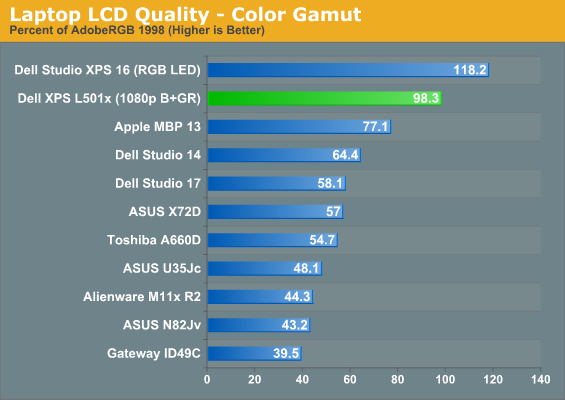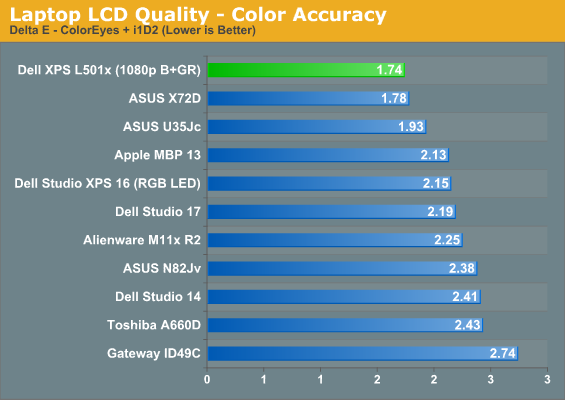There is one flaw with the MacBook Pro's Retina Display that I feel I should point out as it makes it inferior to the best that is out there. Namely, the amount of colors it can display is merely above-average. It's an improvement over the standard MacBook Pro display (except the matte upgrade), but it can barely hold a candle to the best displays out there, speaking strictly of color reproduction.

Covering 67% of the AdobeRGB color gamut is quite good for a mobile display, with few displays passing it besides last year's matte MacBook Pro being able to display 7% more colors and Razer's high-priced Blade reaching 85%. Though when we compare it to the best available in a laptop, it doesn't look quite as good.
Let's add the king of color gamut displays to the mix, made by AUO and used by Dell in 2011's XPS 15, Lenovo's W520 as well as almost the full lineup of Clevo/Sager 15" laptops. (Tested as the XPS L501X here.)

98% of AdobeRGB is a marked improvement. This also contributes to a better color accuracy.


What does the color gamut "deficiency" (though it's not that bad to be called that...) mean? The Retina MacBook Pro can't show colors as true-to-life and vividly as some of the best PC displays. While this is a non-issue to most people, especially as they won't be comparing displays and the MacBook Pro's resolution punch makes up for it, somebody like me who purchased a Clevo laptop with a 95% NTSC color gamut display has to wonder how much I'll miss it if I sell it for the Retina MacBook pro. It seems odd to worry as the MacBook Pro Retina is still the king of displays with its resolution, though colors really do pop off the screen with the 95% color gamut display - and I suspect web-site images will look better thanks to the 1200p resolution not exposing the pixilation. The trade-off is sharper text for more blocky, slightly less vivid images.
Ironically, one of the main reasons I may keep my 95% color gamut Clevo would be for the display. Although I will take another look at the Retina MacBook Pro tomorrow and write-up a comparison. Too bad I won't be able to purchase the RMBP until I sell this otherwise I would be doing a side-by-side comparison.
The ability to display 23% more colors really makes a noticeable difference compared to a standard 72% NTSC color gamut display, though the Retina MacBook Pro has a very non-standard 72% display so it could be a fair trade.
So the Retina MacBook Pro display is not the end-all king of laptop displays in one significant way, although it keeps its crown otherwise.

Covering 67% of the AdobeRGB color gamut is quite good for a mobile display, with few displays passing it besides last year's matte MacBook Pro being able to display 7% more colors and Razer's high-priced Blade reaching 85%. Though when we compare it to the best available in a laptop, it doesn't look quite as good.
Let's add the king of color gamut displays to the mix, made by AUO and used by Dell in 2011's XPS 15, Lenovo's W520 as well as almost the full lineup of Clevo/Sager 15" laptops. (Tested as the XPS L501X here.)

98% of AdobeRGB is a marked improvement. This also contributes to a better color accuracy.


What does the color gamut "deficiency" (though it's not that bad to be called that...) mean? The Retina MacBook Pro can't show colors as true-to-life and vividly as some of the best PC displays. While this is a non-issue to most people, especially as they won't be comparing displays and the MacBook Pro's resolution punch makes up for it, somebody like me who purchased a Clevo laptop with a 95% NTSC color gamut display has to wonder how much I'll miss it if I sell it for the Retina MacBook pro. It seems odd to worry as the MacBook Pro Retina is still the king of displays with its resolution, though colors really do pop off the screen with the 95% color gamut display - and I suspect web-site images will look better thanks to the 1200p resolution not exposing the pixilation. The trade-off is sharper text for more blocky, slightly less vivid images.
Ironically, one of the main reasons I may keep my 95% color gamut Clevo would be for the display. Although I will take another look at the Retina MacBook Pro tomorrow and write-up a comparison. Too bad I won't be able to purchase the RMBP until I sell this otherwise I would be doing a side-by-side comparison.
The ability to display 23% more colors really makes a noticeable difference compared to a standard 72% NTSC color gamut display, though the Retina MacBook Pro has a very non-standard 72% display so it could be a fair trade.
So the Retina MacBook Pro display is not the end-all king of laptop displays in one significant way, although it keeps its crown otherwise.
Last edited:

